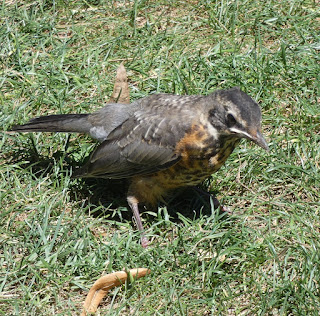Female American Redstart
Cedar Waxwing
Birding Central Park style
Magnolia Warbler (File shot) - Unable to get clear shot
Warbling Vireo
Baltimore Oriole
Red-bellied Woodpecker
Black-crowned Night Heron
Red-winged Blackbird
White-throated Sparrow
Northern Flicker
Blue Jay
Grey Catbird Juvenile
Early morning Racoon
Grey Catbird
Mourning Dove
Great Crested Flycatcher
Eastern Kingbird
Mrs D getting into the Central Park vibe
Juvenile American Robin
RAfter a great trip last year we decided on a return trip to New York with the lads to share some of the fantastic experiences the city offers. Despite a ballistic schedule I shuffled in a session of birding in Central Park on the Saturday morning. Traditionally, July is a poor month but on occasions if you get a wind blowing from north west you can pick up a returning warbler or two. The forecast did give me hope as I entered the park at 5.15am. The dawn chorus was amazingly loud as I met up with local guide and six other birders from round the world.
Blue Jay, American Robin, Common Grackel & Mourning Dove started the day list off before leaving the boat house. There were plenty Starlings at most locations we visited which are having an adverse effect of the tree cavity nesting birds of the park.
Birds I'd seen on my previous visit recorded again included Northern Cardinal, Chimney Swift, Downey Woodpecker, Double-crested Cormorant, Red-bellied Woodpecker, Grey Catbird, Northern Flicker, House Finch and the common Canada Goose & Mallard.
Eight Barn Swallows were seen over the Great Lawn baseball fields which was a species all of us knew well. In the same area there were at least 2 pairs of Red-winged Blackbirds, I'd only seen them on the way to airport previously.
The first lifer of the morning was one of three Warbling Vireo's singing at Oak Bridge, Maintence Field & Warbler Rock. This was followed by a bird I wasn't expecting to see a Great Crested Flycatcher, originally perched very high but did come down to give us better views. I then picked up a juvenile Baltimore Oriole (another lifer) which was actually in a family group. Another a male was also noted at Warbler Rock.
A species I was really hoping would still be around would be the Cedar Waxwings. A much smaller bird than our visiting Bohiemum species, we observed two adult birds feeding young above the Shakespeare Gardens.
This was quickly followed up by visiting another pair of nesting lifers which were the Eastern Kingbirds that showed right above us. How I'd like to see one of these in the UK.
Two White-throated Sparrows have been summering in the park a long way from where they should be and it was great to catch up with the pair deep into the ramble.
With time getting on I thought the chances of getting a new warbler were decreasing by the second. Then suddenly as we were watching another Oriole a female American Redstart popped up ! I was literarily foaming at the mouth as this is one of my most wanted birds. The rest of the group seemed pleased but non plus at the same time.
Then the bird of the morning appeared a magnificent Magnolia Warbler right above us flicking and moving on both sides of the patch. I could have spent an hour watching only this stunning american male warbler.
After a great session I met up with the family at the boat house to watch the world cup quarter final, England winning 2-0. After the game we checked out the reservoir which had 20 American Herring Gulls & 5 Great Black-backed Gulls bathing in the middle.
Other species recorded on the trip included Common tern & Laughing Gull on the Staten Island Ferry & an American Crow & Chimney Swift over Yankee Stadium.
1) Magnolia Warbler
2) American Redstart
3) Cedar Wawing
4) Great Crested Flycatcher
5) Warbling Vireo
6) Baltimore Oriole
7) Eastern Kingbird
8) House Sparrow
9) Common Grackle
10) Red-winged Blackbird
11) American Herring Gull
12) Laughing Gull
13) Great Black-backed Gull
14) Mallard
15) Great Cormarant
16) Double-crested Cormorant
17) American Robin
18) White-throated Sparrow
19) Red-bellied Woodpecker
20) Northern Cardinal
21) Barn Swallow
22) Chimney Swift
23) Black-crowned Night heron
24) Blue Jay
25) Common Tern
26) Red-breasted Nuthatch
27) White-breasted Nuthatch
28) Red-tailed Hawk
29) Downey Woodpecker
30) Northern Flicker
31) American Crow
32) Starling
33) Canada Goose
34) Grey Catbird
35) Mourning Dove
Italic = lifers























No comments:
Post a Comment